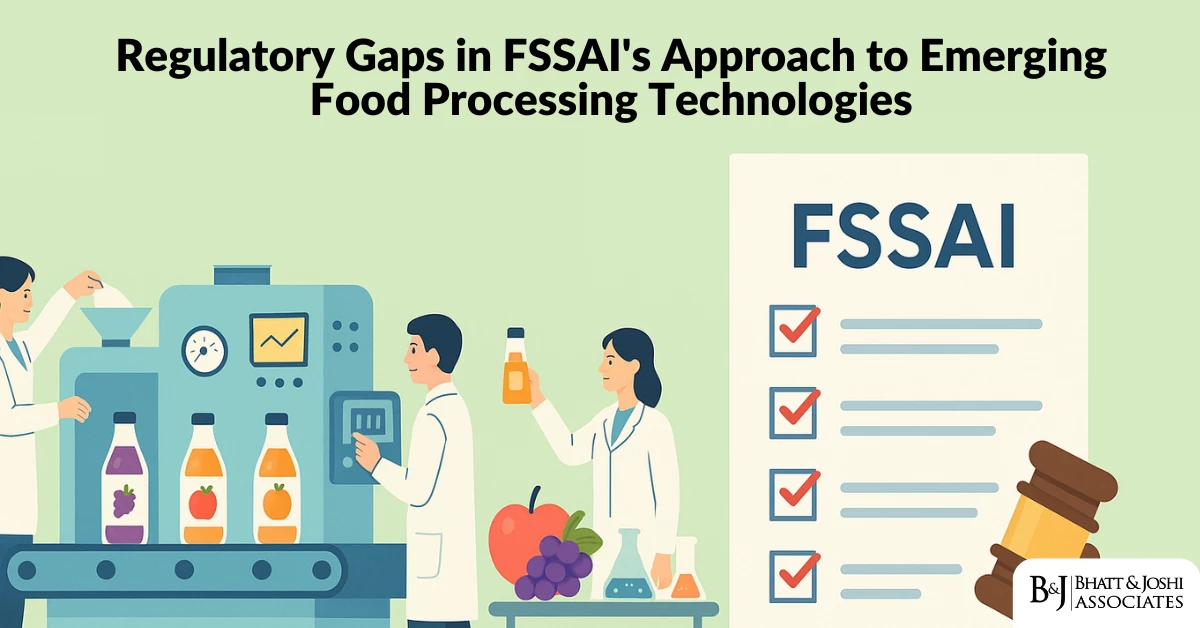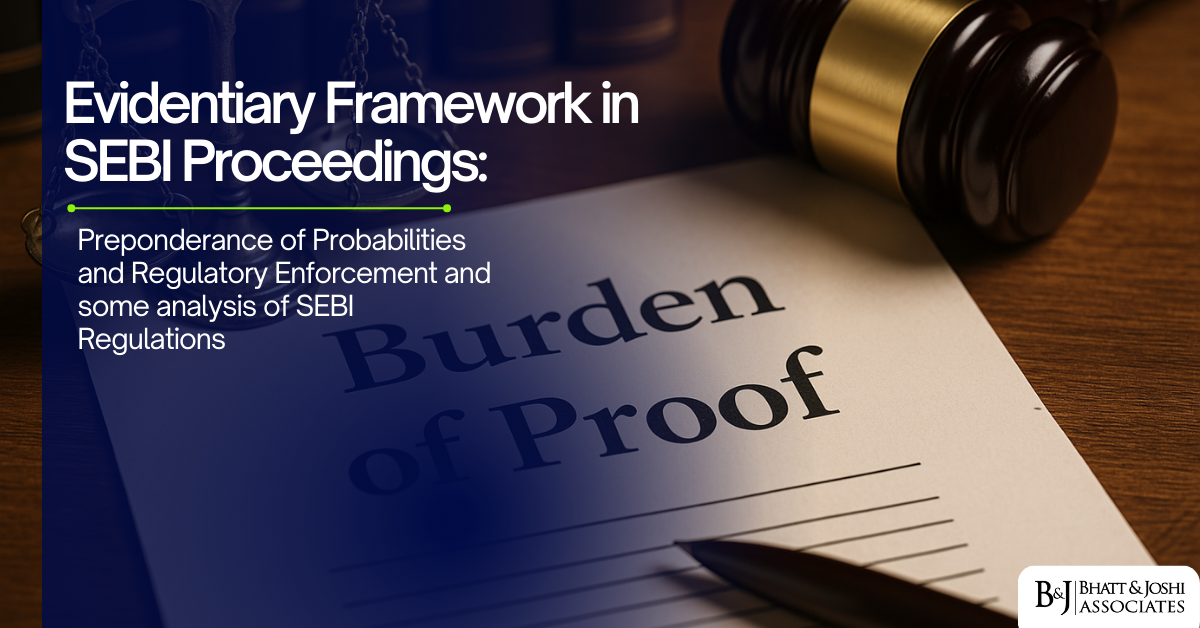Introduction
Technological innovation drives constant evolution in food processing methods, creating novel approaches that may enhance food safety, extend shelf life, improve nutritional quality, or address environmental concerns. However, these emerging technologies frequently outpace regulatory frameworks designed for conventional processing methods, creating significant legal and regulatory gaps. In India, the Food Safety and Standards Authority of India (FSSAI) faces particular challenges in developing appropriate oversight for novel food processing technologies while balancing innovation promotion with consumer protection. This article examines the regulatory gaps in FSSAI’s approach to emerging food processing technologies, analyzing the current framework, specific technological innovations facing inadequate regulation, risk assessment limitations, approval mechanisms, legal challenges, and potential pathways for regulatory evolution to address these gaps.
Current Regulatory Framework of Food Processing Technologies
The Food Safety and Standards Act, 2006 establishes the foundational legislative framework for food regulation in India, creating FSSAI as the apex regulatory body with broad authority over food safety and standards. While this comprehensive legislation grants FSSAI significant powers to regulate food production and processing, it was drafted before many emerging technologies gained prominence, creating inherent limitations in addressing novel methods.
Section 16(2)(d) of the Act empowers FSSAI to “specify appropriate systems of enforcing various standards,” while Section 18(2)(d) directs the Authority to “ensure that there is open and transparent public consultation” when carrying out risk assessment. These provisions theoretically enable FSSAI to regulate novel technologies, but lack specific provisions addressing the unique challenges they present. This creates a situation where emerging technologies must be regulated through frameworks designed for conventional processes, potentially creating misalignments between regulatory requirements and technological realities.
The Food Safety and Standards (Food Products Standards and Food Additives) Regulations, 2011, provide more detailed requirements for processing methods but similarly focus primarily on conventional techniques. Regulation 2.2 addresses processing aids, while various product-specific regulations contain limited provisions regarding permitted processing methods. These regulations frequently specify what processing aids are permitted but provide minimal guidance on novel processing technologies themselves.
The Novel Food Regulations, formally titled Food Safety and Standards (Approval of Non-Specified Food and Food Ingredients) Regulations, offer the primary regulatory pathway for foods produced using new technologies. These regulations require pre-market approval for “foods manufactured/processed using novel technology” where safety has not been established. However, they provide limited guidance on evaluation criteria specifically for novel processing methods, focusing more on novel ingredients or compositional characteristics than processing innovations.
This regulatory framework creates several fundamental gaps in addressing emerging technologies. First, the emphasis on final product characteristics rather than process validation creates uncertainty about how processing innovations will be evaluated. Second, the absence of specific testing protocols for novel technologies leaves substantial discretion to scientific panels evaluating such methods. Third, the lack of clear categorization criteria for determining when a technology requires novel food approval versus when it can be considered a variation of existing approved methods creates regulatory uncertainty for innovators.
Technological Innovations Facing Regulatory Gaps
Several emerging food processing technologies face particular regulatory challenges due to gaps in the current framework. High-Pressure Processing (HPP), also known as high hydrostatic pressure processing, uses elevated pressures (300-600 MPa) to inactivate microorganisms and enzymes without thermal treatment. While HPP has gained significant international adoption for products like juices, ready-to-eat meats, and guacamole, its regulatory status in India remains ambiguous. No specific standards address HPP validation requirements, leading to inconsistent approaches where some HPP products undergo novel food review while others enter the market without specific approval based on arguments that the final product meets existing standards.
This regulatory uncertainty was highlighted in a 2022 case where an HPP juice processor challenged an FSSAI directive requiring novel food approval. The company argued that since the final product met microbiological standards established in the Food Safety and Standards (Food Products Standards and Food Additives) Regulations for conventional juices, no additional approval should be required. While the case was ultimately settled through administrative channels rather than formal adjudication, it highlighted the absence of clear criteria for when novel processing methods require specific approval versus when meeting final product standards suffices.
Nanotechnology in food processing presents even more significant regulatory gaps. The application of engineered nanomaterials in food processing, packaging, and as food additives raises unique safety questions due to potentially altered absorption, distribution, and toxicity profiles compared to conventional forms of the same substances. Despite these distinct characteristics, FSSAI regulations contain no specific provisions addressing nanomaterials in food, creating fundamental uncertainty about their regulatory status.
The absence of a regulatory definition for nanomaterials in food applications represents the most basic gap, leaving uncertainty about when a material qualifies for nano-specific consideration. This contrasts sharply with the European Union’s approach, which defines nanomaterials as “any intentionally manufactured material, containing particles, in an unbound state or as an aggregate or as an agglomerate and where, for 50% or more of the particles in the number size distribution, one or more external dimensions is in the size range 1 nm-100 nm.”
Without such definitions or specific testing requirements, nanomaterials in food applications face inconsistent regulatory treatment. Some are evaluated as novel food ingredients, others as food additives under conventional frameworks, and some may enter the market without specific nano-related review if they use substances generally recognized as safe in conventional forms. This regulatory ambiguity creates both safety concerns and market uncertainties.
Cell-based meat technologies present perhaps the most complex regulatory challenge. These production methods, which culture animal cells to produce meat without conventional animal slaughter, blur traditional categories of agricultural products, processed foods, and biotechnology. In 2021, a cell-based meat company seeking clarity on the regulatory pathway for its products received conflicting guidance from different FSSAI departments, with some suggesting novel food approval while others questioned whether such products could be classified as “meat” under existing definitions.
This regulatory confusion stems from the FSS Act’s product category definitions, which did not anticipate meat products produced without animal slaughter. The Food Safety and Standards (Food Products Standards and Food Additives) Regulations define meat as “the dressed flesh of animals,” without addressing whether cultured cells qualify as such. This definitional gap creates fundamental uncertainty about the appropriate regulatory pathway, potentially inhibiting investment in this emerging sector.
Risk Assessment Protocols for Emerging Food Technologies
The limitations in FSSAI’s approach to novel food processing technologies extend beyond regulatory framework gaps to practical risk assessment protocols. Scientific Panel expertise gaps represent a significant challenge when evaluating emerging technologies. The Scientific Panels established under Section 13 of the FSS Act form the primary evaluation mechanism for novel foods and technologies. However, these panels may lack specialists in specific emerging technologies, creating situations where novel methods are evaluated by experts primarily familiar with conventional processes.
This expertise gap became evident during the 2020 evaluation of a pulsed electric field processing system, where the Scientific Panel sought external expert consultation due to limited internal expertise. While the Panel appropriately recognized this limitation, the process highlighted the absence of standardized procedures for incorporating specialized technological expertise into evaluations, potentially leading to inconsistent approaches across different applications.
Inadequate testing standards for technology-specific parameters represent another significant gap. Current protocols focus primarily on final product characteristics rather than process validation parameters specific to novel technologies. For instance, while conventional thermal processing has well-established parameters (F-values, z-values, thermal death time), equivalent standardized parameters for emerging non-thermal technologies remain undefined in Indian regulations.
This testing standardization gap creates several problems: (1) applicants lack clear guidance on what evidence will satisfy regulators; (2) evaluators lack consistent criteria for assessment; and (3) enforcement officers lack clear parameters for post-approval monitoring. The absence of technology-specific validation protocols means that safety evaluations may miss unique risk factors associated with novel methods.
International benchmarking reveals significant gaps compared to more developed regulatory systems. The U.S. Food and Drug Administration (FDA) has established specialized guidance documents for specific novel technologies, including Pulsed Electric Field (PEF) processing, UV treatment, and ultrasound. Similarly, the European Food Safety Authority (EFSA) has developed specific assessment protocols for emerging technologies like high-pressure processing and plasma treatment. These international approaches provide structured evaluation frameworks addressing the unique characteristics of each technology rather than applying generic novel food assessment approaches.
FSSAI’s approach has generally involved applying the same broad novel food assessment framework to all emerging technologies, sometimes supplemented by ad hoc requests for additional information. This one-size-fits-all approach fails to address the unique characteristics and risk profiles of different technologies, potentially leading to both excessive burdens for low-risk innovations and inadequate evaluation of technologies with unique risk profiles.
Approval Mechanisms for New Technologies
The regulatory pathways for approving novel food processing technologies under the current framework present several challenges. The Product Approval Process established under the Food Safety and Standards (Approval of Non-Specified Food and Food Ingredients) Regulations represents the primary mechanism for evaluating novel technologies. This process requires extensive documentation, including detailed information on the novel technology, safety assessment data, and proposed quality and safety parameters.
While this framework theoretically accommodates novel processing methods, several limitations create practical challenges. The application requirements focus primarily on compositional characteristics and final product safety rather than process validation parameters. This product-centric approach may inadequately address the unique aspects of process innovations, particularly those that may create transient intermediates or process-specific contaminants not captured in final product testing.
The approval timeline presents another significant challenge. Novel food applications typically face review periods exceeding 12 months, with multiple rounds of additional information requests. For rapidly evolving technologies, this extended timeline creates substantial business uncertainty and may deter investment. The lack of expedited pathways for technologies with established safety records in other jurisdictions further compounds this challenge.
The absence of a conditional approval mechanism represents another significant gap. Unlike some international regulatory systems, FSSAI lacks provisions for granting conditional or provisional approvals that would allow limited market introduction with enhanced monitoring requirements. Such mechanisms could facilitate responsible innovation while gathering additional real-world safety data, but remain unavailable under current frameworks.
A 2021 case involving a high-pressure processing application illustrates these challenges. The applicant received four rounds of additional information requests over 18 months, with each request focusing on different aspects of the technology. When approval was finally granted, the authorization specified product-specific parameters rather than technology validation criteria, necessitating new approvals for each product category despite using identical processing parameters. This application-by-application approach creates substantial inefficiencies compared to technology-platform approvals granted in some other jurisdictions.
Legal Challenges in Novel Food Processing Regulation
The regulatory gaps surrounding novel food processing technologies have increasingly led to legal challenges and judicial interventions that shape the evolving regulatory landscape. Industry litigation has primarily focused on challenging FSSAI’s authority to require novel food approval for products using emerging technologies when the final products meet existing standards. A significant case arose in 2020 when a food company challenged FSSAI’s requirement for novel food approval of cold plasma-treated spices. The company argued that since the final products met all microbiological and chemical safety standards for conventional spices, additional approval requirements constituted regulatory overreach.
The Delhi High Court’s interim ruling in this case established an important principle, stating that “while FSSAI has broad authority to ensure food safety, this authority must be exercised reasonably and with due regard for established standards.” The Court allowed the company to continue selling the products pending final resolution, provided they met all existing product standards and maintained detailed processing records. This ruling suggested judicial receptiveness to arguments that novel processing methods producing compliant final products should face streamlined regulation, though it stopped short of establishing a definitive precedent.
Consumer protection cases have created counterbalancing pressure for more comprehensive regulation of novel technologies. In 2022, a consumer advocacy organization filed public interest litigation arguing that FSSAI’s ad hoc approach to novel food technologies failed to adequately protect public health. The petition specifically cited the lack of nano-specific regulations as creating potential safety risks. While this case remains pending, it highlights the dual pressures FSSAI faces—from industry seeking regulatory streamlining and from consumer advocates seeking more comprehensive oversight.
Regulatory evolution in response to judicial mandates has shown some progress but remains incomplete. Following various legal challenges, FSSAI initiated a comprehensive review of its novel food regulations in 2023, establishing a working group to develop technology-specific guidance documents. This initiative acknowledges the limitations of the current one-size-fits-all approach but has yet to produce finalized guidance documents for specific technologies.
The working group’s preliminary report, released in December 2024, recommended developing “technology-specific protocols rather than applying generic novel food frameworks to diverse processing innovations.” This recommendation, if implemented, would represent a significant evolution in FSSAI’s approach, potentially addressing many of the gaps identified by both industry and consumer advocates.
Comparative International Approaches
Examining how other major regulatory jurisdictions address emerging food processing technologies provides valuable context for understanding FSSAI’s gaps and potential pathways for improvement. The United States Food and Drug Administration (FDA) employs a flexible approach centered on the concept of “reasonable certainty of no harm” rather than requiring pre-market approval for all novel technologies. When a food company intends to introduce a significant new processing technology, they may seek a “No Questions Letter” through the FDA’s voluntary consultation process or file a Food Contact Notification for technology-specific components that may migrate into food.
This approach places substantial responsibility on manufacturers to ensure safety while providing regulatory recognition when appropriate. For several emerging technologies, the FDA has published specific guidance documents detailing recommended validation approaches. For instance, the 2020 guidance on high-pressure processing specifies validation parameters, verification requirements, and record-keeping obligations specific to this technology.
The European Food Safety Authority (EFSA) has developed perhaps the most comprehensive framework for novel food processing technologies. The Novel Food Regulation (EU) 2015/2283 explicitly includes foods produced using new technologies within its scope. EFSA has established technology-specific guidance documents addressing the unique characteristics of various emerging methods. For instance, the EFSA Panel on Food Contact Materials has published specific guidance on nanotechnology risk assessment, addressing the unique considerations for nanomaterials in food applications.
A particularly notable aspect of the European approach is the distinction between technology approval and product approval. In some cases, a novel technology may receive a general safety assessment applicable across multiple applications, streamlining subsequent product-specific approvals using that technology. This platform approach potentially reduces regulatory burdens for widely applicable processing innovations.
Japan’s regulatory system offers another instructive model, employing a combination of mandatory pre-market approval for novel food additives and voluntary consultation for novel processing technologies. The Japanese Ministry of Health, Labour and Welfare has established specialized expert committees for evaluating specific emerging technologies, providing consistent and specialized review. This targeted expertise approach helps address the knowledge gaps that can occur when general food safety experts evaluate highly specialized technologies.
In contrast to these more developed regulatory frameworks, FSSAI’s approach to novel processing technologies remains less structured and more case-by-case. The absence of technology-specific guidance documents, specialized review panels for emerging technologies, and clear distinctions between technology platform approvals versus product-specific approvals creates significant gaps compared to international best practices.
Recommendations for Regulatory Evolution
Addressing the regulatory gaps in FSSAI’s approach to emerging food processing technologies requires systematic reforms to create a more nuanced, technology-appropriate framework. Developing technology-specific guidance documents represents an essential first step. Rather than applying generic novel food assessment frameworks to all emerging technologies, FSSAI should develop specialized guidance for major categories of novel processing methods, including high-pressure processing, pulsed electric fields, cold plasma, and nanotechnology applications.
These guidance documents should clearly specify: (1) appropriate validation parameters specific to each technology; (2) necessary safety data requirements tailored to the unique aspects of each process; (3) standardized testing methodologies; and (4) record-keeping requirements for ongoing verification. By creating technology-specific frameworks, FSSAI would provide much-needed clarity to both industry and evaluators, improving consistency and scientific rigor in assessments.
Establishing specialized expert committees for emerging technologies would address the expertise limitations in current evaluation processes. Rather than routing all novel technology applications through general Scientific Panels, FSSAI should create specialized committees including experts with specific knowledge of emerging processing methods. These committees could develop deeper technological expertise while ensuring consistent evaluation approaches across multiple applications using similar technologies.
Implementing a tiered risk assessment approach would create more proportionate regulatory burdens based on the novelty and potential risk profile of different technologies. Low-risk modifications of existing technologies could follow streamlined pathways, while truly novel methods with limited safety history would undergo more comprehensive assessment. This risk-based approach would more efficiently allocate regulatory resources while facilitating responsible innovation.
Developing a technology platform approval mechanism would significantly improve regulatory efficiency. Rather than requiring novel food approval for each product using an already-evaluated technology, FSSAI could establish a framework for approving processing technologies as platforms, allowing subsequent product applications using approved technologies to follow a simplified pathway focused on product-specific considerations rather than re-evaluating the core technology.
Enhancing international regulatory cooperation represents another important avenue for improvement. While FSSAI must develop India-specific regulations appropriate to local conditions, greater alignment with international approaches would benefit both regulators and industry. Formal mechanisms for considering safety evaluations conducted by trusted international counterparts could reduce duplication of effort while maintaining appropriate oversight.
Establishing conditional approval pathways would facilitate responsible innovation while gathering additional safety data. For promising technologies with strong preliminary safety evidence but limited commercial history, FSSAI could implement provisional approvals with enhanced monitoring requirements, allowing limited market introduction while gathering additional real-world safety data. This approach provides a middle ground between full approval and rejection, potentially accelerating innovation while maintaining appropriate caution.
Conclusion
The regulatory gaps in FSSAI’s approach to emerging food processing technologies create significant challenges for both innovation and consistent safety oversight. The current regulatory framework, designed primarily for conventional processing methods and focused on final product characteristics, inadequately addresses the unique aspects of novel technologies. This results in uncertainty for industry, inconsistent evaluation approaches, and potential safety oversight gaps for truly novel methods.
The comparative analysis with international regulatory systems reveals substantial opportunities for improvement through more technology-specific approaches, specialized expertise development, platform approvals, and risk-proportionate assessment frameworks. While FSSAI has acknowledged some of these gaps through recent working group initiatives, substantial work remains to develop a comprehensive, science-based regulatory framework for emerging food processing technologies.
Moving forward, addressing regulatory gaps in emerging food processing technologies requires a careful balance of multiple objectives: protecting public health, fostering responsible innovation, ensuring regulatory efficiency, and promoting international harmonization where appropriate. By developing more nuanced, technology-specific regulatory approaches, the FSSAI can better fulfill its consumer protection mandate while supporting India’s food sector in adopting innovations that enhance safety, quality, nutrition, and sustainability.
The path forward likely involves incremental improvements rather than comprehensive regulatory overhaul, with priority given to technologies already gaining market presence like high-pressure processing and pulsed electric fields, followed by emerging methods still in earlier development stages. Through this evolutionary approach, India’s food safety regulatory framework can better address the technological realities of modern food processing while maintaining its foundational focus on ensuring safe food for all consumers.
References
- Food Safety and Standards Act, 2006, No. 34, Acts of Parliament, 2006 (India).
- Food Safety and Standards (Food Products Standards and Food Additives) Regulations, 2011, Gazette of India, Part III, Sec. 4 (India).
- Food Safety and Standards (Approval of Non-Specified Food and Food Ingredients) Regulations, 2017, Gazette of India, Part III, Sec. 4 (India).
- High-Pressure Processor v. FSSAI, Delhi High Court, Writ Petition (Civil) No. 7245 of 2022 (Settled).
- Consumer Advocacy Organization v. Union of India & Ors., Public Interest Litigation No. 34 of 2022, Delhi High Court (Pending).
- Cold Plasma Technologies Ltd. v. FSSAI, Delhi High Court, Writ Petition (Civil) No. 5632 of 2020.
- FSSAI Working Group on Novel Processing Technologies. (2024, December). Preliminary Report on Technology-Specific Regulatory Approaches. New Delhi: FSSAI.
- U.S. Food and Drug Administration. (2020). Guidance for Industry: Hazard Analysis and Risk-Based Preventive Controls for Human Food – Draft Guidance – Chapter 4: High Pressure Processing.
- European Food Safety Authority. (2018). Guidance on risk assessment of the application of nanoscience and nanotechnologies in the food and feed chain. EFSA Journal, 16(7), 5327.
- Regulation (EU) 2015/2283 of the European Parliament and of the Council of 25 November 2015 on novel foods.
- Nishith Desai Associates. (2023). Regulatory Update 2023: Food Industry in India.
- Ministry of Health, Labour and Welfare, Japan. (2022). Framework for Evaluation of Novel Food Processing Technologies. Tokyo: MHLW.
- FSSAI Scientific Panel on Functional Foods, Nutraceuticals, Dietetic Products and Other Similar Products. (2024). Minutes of the Meeting, 14th Session, December 2024.
- FSSAI. (2022). Annual Report 2021-2022. New Delhi: Food Safety and Standards Authority of India.
- Cell-Based Meat Company correspondence with FSSAI, Reference No. TECH/CBM/2021/03, dated March 15, 2021.














